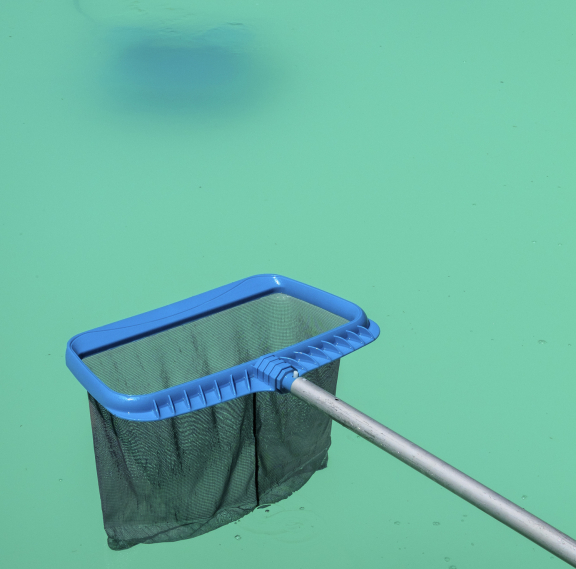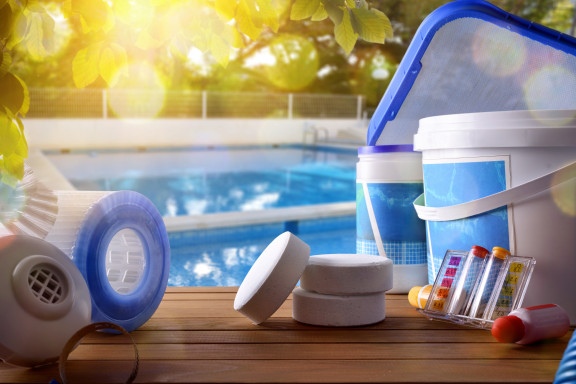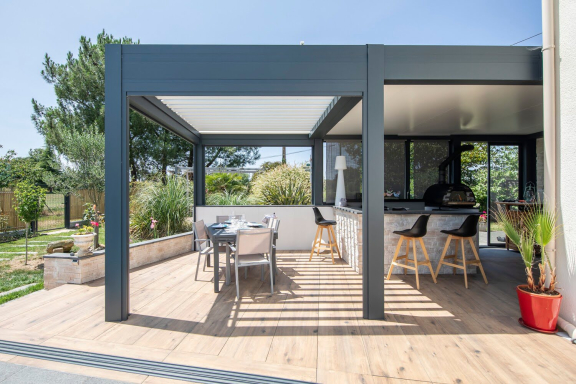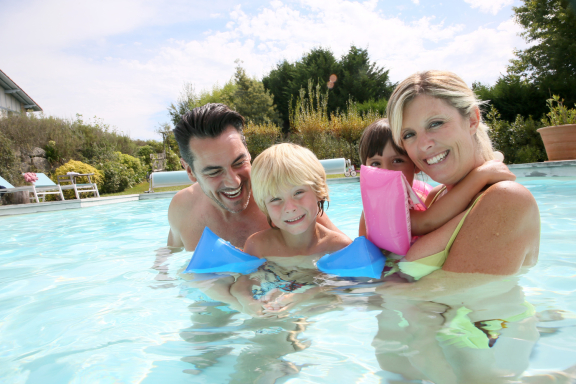My pool water is cloudy: explanations and solutions
Fine particles, milky water, foam, oily residue, etc. All these inconveniences are common in a pool, but cloudy water is not really inviting to bathers and may be the sign of a problem that must be rapidly solved in order to avoid damaging equipment or to make the pool unusable. So, how do you explain this cloudy water? What solutions are available to recover clear water that is a pleasure to bathe in? See our complete guide to understanding where cloudy pool water comes from and how to get rid of it.
Why is your pool water cloudy?
Numerous elements can trouble pool water. You must be able to identify the problem to treat it effectively.
Poorly balanced water
The most common cause of cloudy pool water is unbalanced water.
This means there is an imbalance in the quantity of chlorine in the pool or in the pH, which may be too acidic or alkaline.
Dirty water
The debris that falls into the pool can leave sand and fine particles in the water. When the pool water is slightly cloudy, it is sometimes simply a sign that it is time to clean the pool or equipment.
Algae
When algae develop in a pool, they can trouble the water. As algae are not only green (they can sometimes even be white), you may not notice them right away, but they will cloud the water.
Milky water may also be caused by dead algae in the pool, especially when it has been necessary to perform a shock treatment. In this case, there is nothing to worry about, the water simply needs to be filtered.
Excessive hardness
We say pool water is hard when it contains too much calcium. This problem is generally caused by a pH level that is too high.
Calcium in the form of limescale can damage the equipment, and clog the filter sand in particular. As the water is no longer correctly filtered, the dust remains and the pool water turns cloudy.
Bad weather
It is frequent to find your water has turned cloudy after a storm or heavy rain. In fact, rainwater, which contains numerous particles, can pollute the pool and unbalance the pH.
You will then have to clean the pool and rebalance the water. To avoid this type of inconvenience, you can simply cover your pool in case of bad weather.
The different solutions in case of cloudy water
Once you have determined the cause of your cloudy water, you can implement several solutions to recover clear water.
Filtration
The first thing to do solve the problem of cloudy water is launch the filtration system. You can run it longer than usual to ensure that all debris is filtered.
Also check that the filtration operates correctly and ensure that no parts are damaged and the filter is not clogged.
Filtration is one of the elements that enable pool water to stay clean. If cloudy pool water is caused by an excessive quantity of debris in the water, filtration will enable you to recover clean, clear water. Filtration may also be facilitated by the use of a flocculant.
pH and chlorine
If your pool water is cloudy due to a lack of chlorine, you simply need to add more. If, on the other hand, it is due to a pH imbalance, you will have to rectify it with a suitable product. pH Plus enables you to increase pH, while pH Minus decreases it.
Here are the general rules to respect in order to ensure that your pool water remains clean and ideal for bathing:
– pH (which means hydrogen potential) represents the concentration of hydrogen ions in the water. It should be between 7.2 and 7.4. Depending on local conditions (the region and hardness of the water, in particular), it may be slightly different from this level. Above 8, the pH is basic and the water is alkaline. Below 6, the water is acidic.
– The quantity of chlorine must be between 1.5 and 2 mg per litre of water. Too much chlorine can damage the liner and swimming costumes as well as cause irritation. However, water that does not contain enough chlorine will not be sufficiently disinfected and will thus create an environment that is favourable for the development of bacteria.

Flocculant
To facilitate the filtration of pool water, you can add a flocculant, which is sometimes called a clarifier.
A flocculant coagulates the finest particles in the water, those that are too small to be properly filtered. After coagulating, they can be captured by the filter.
Flocculants come in different forms:
– Liquid clarifier, which is diluted directly in the pool water.
– Cartridge clarifier, which is placed in the filtration system and can be used preventatively, especially if the water in your area is very hard.
– Clarifying tablets, which are placed in the skimmers.
Of course, you must respect the manufacturer's recommended doses and choose a product that is suitable for the other treatments you already use, as well as your filtration system.
If you have had to carry out a shock treatment against algae and there are still some deposits remaining in the pool, a flocculant will help you get rid of all these particles and recover clean water.
Anti-limescale treatment for milky water
If your pool water is white and cloudy, the problem is probably due to limescale. In this case, you should use an anti-limescale treatment and then regularly control the limescale level. Indeed, the water in certain regions is hard, which facilitates the development of limescale.
An anti-limescale treatment can be used to solve a limescale problem, but can also be used as a preventive treatment, especially when you know that your pool is at risk.
When limescale has already built up, you should remove it by scrubbing with a brush and an anti-limescale product. As this task is quite tiresome, it is best to anticipate the development of limescale with a preventive treatment before it builds up.
Clean the pool
In addition to the treatments that will enable you to get rid of cloudy pool water, make sure you give your pool a good cleaning before you run the filtration system. You will thus remove all the deposits that can increase the cloudiness of the water.
Effective pool cleaning must be done meticulously. Indeed, a pool consists of several elements that must all be regularly cleaned.
Therefore, you should brush the sides of the pool and remove debris from the surface of the water, but also remember to wash the skimmers, filtration system and nozzles.
What maintenance to avoid cloudy pool water?
Regular and careful maintenance is the first thing you should do to avoid cloudy water.
The equipment necessary to clean your pool
Your pool needs to be cleaned several times during the season. You will need several accessories to do this:
– A skimmer net to remove the largest debris that has fallen into the pool and clean the surface of the water;
– A manual vacuum cleaner to manually clean the bottom and sides of the pool;
– A pool robot to automate and simplify cleaning;
– A brush for the sides of the pool;
– A magic eraser, brush or micro-fibre cloth to clean the waterline.

The importance of filtration
Cleaning is not enough to ensure clean water. Indeed, if the pool water stagnates, it will end up by turning cloudy. This is when filtration comes into action by enabling the water to circulate.
The filtration system consists of several elements: skimmers, nozzles, pump and filter. Each of these elements has its importance, so it is essential to regularly check that they are working correctly and clean them.
The filter is particularly important because it is what eliminates the impurities that are found in the pool.
A sand filter is the most common type of filtration system. It can clog and must therefore be cleaned from time to time and even replaced when no longer effective.
Water treatment
Well-balanced and disinfected water is one of the key elements to avoid cloudy pool water.
Water is mainly treated by the anti-bacterial action of chlorine. If you do not have a chlorine pool, you will use bromine or active oxygen.
To keep your water healthy, you will have to check the chlorine and pH levels weekly and adjust them when necessary. You can also complete this treatment with other products, such as algaecide or an anti-limescale treatment.
How can you recuperate cloudy pool water naturally?
A few tips may help you keep your water clear while using natural products. Nevertheless, be careful: it is not because these treatments are natural that they must not be used carefully and, in certain situations, they may not be sufficient.
Sodium bicarbonate
Very useful for household tasks, sodium bicarbonate consists of alkaline substances with disinfecting properties.
It can purify pool water and increase the pH. By eliminating bacteria and balancing the water, it helps to eliminate cloudy water and even prevent the formation of limescale.
To use it correctly, pour the bicarbonate into the pool and allow it to react overnight before vacuum cleaning and filtration.
Hydrogen peroxide
Also called active oxygen, hydrogen peroxide is a powerful disinfectant that can complete the action of chlorine or bromine. It can help combat algae and purify pool water.
It can be used for both regular and shock treatment.
How do you remove sediment from the bottom of your pool?
The debris that falls into your pool may sink to the bottom and turn the water cloudy. Fortunately, this is not too serious and, with the right equipment, the bottom of your pool will be relatively easy to clean.
The pool robot
The easiest solution to effectively clean the bottom of your pool is to use a pool robot. The advantage: it takes care of cleaning for you, with no need for surveillance.
There are different types of pool robots, including electric, hydraulic suction and hydraulic pressure robots, the first of which is generally considered as a safe bet for effective cleaning.
Certain very powerful models can also clean the pool walls or steps.
The manual vacuum cleaner
A vacuum cleaner is the manual solution to clean the bottom of a pool.
This type of cleaner is equipped with a telescopic handle and a rectangular head. It connects to the pool filtration system. Thus, you can both brush and vacuum the impurities for filtering.
The use of a manual vacuum is more demanding than a robot because it requires some physical effort and time. Nevertheless, it remains useful to clean the places that a robot may find difficult to access, such as corners (in which case a triangular head will be useful).
It is worth keeping one among your maintenance equipment for exceptional cleaning or in case your robot breaks down.
How can you recover clean water in a very dirty pool?
A very dirty liner, sand at the bottom of the pool, fatty residue: cloudy water may simply be very dirty water. How can you clean it effectively?
Cleaning a very dirty pool liner
The magic eraser that you may use for the regular maintenance of your liner will also be useful if it is particularly dirty... with a little more elbow grease!
You can also use a product to facilitate cleaning. Liner cleaners are available, but white vinegar can also do the trick. Apply the product to a sponge and rub with a circular movement to absorb dirt without damaging the liner.
If your liner is really dirty, try to determine whether it is a problem of limescale or algae to be sure to apply the correct treatment.
Mud or sand at the bottom of the pool
You may find sand, or even mud, at the bottom of your pool, after winterising, for example. In this case, can you use your regular equipment to clean the pool?
If you have a little sand at the bottom of your pool, the pool robot will do the job. But if there is a significant quantity or if there is mud, you will have to start with the manual vacuum cleaner to remove the largest part of the dirt, before finishing with your robot.
Removing debris and fatty residue from the pool
Cloudy water may be due to fatty residue that clings to the walls of the pool or floats at the surface. These oily deposits are generally caused by the suncare products or makeup of pool users, as well as the pool environment.
You can use an absorbent micro-fibre cloth to get rid of these deposits. Place it in the surface skimmer so that it retains all the oily particles that arrive in the filtration system. Remember to replace this cloth when it becomes too dirty to be effective.
Another tip to get rid of oil in your pool is to use tennis balls: place five to ten balls in the water overnight to allow them to absorb the oil. You can then remove them and wash them in the washing machine before using them again when necessary.
What should you do about foam in your pool water?
It is absolutely normal for pool water to foam while swimming. However, if you see that there is still foam on the water several hours after use, there is indeed a problem that needs attention.
Why is there foam in your pool?
Several reasons may explain why there is foam in your pool water:
– The use of an algaecide. Algaecide and fungicide treatments can create foam. So, there is nothing to worry about if you see foam after using them.
– The presence of algae. When they develop on pool walls, algae can create an impression of foaminess.
– The presence of soap. Bathers may carry soap or other organic waste into the pool with them.
– The nature of the water. Soft water will foam more easily. Depending on the region, it may be more common to see foam in pool water.
The solutions to combat foamy pool water
If you regularly observe foam in your pool, start by making sure that it is not caused by algae.
Then check the pH and rebalance it if necessary.
Also, run the filtration system to remove any debris that may be caused by the surrounding environment or bathing.
Finally, you can also use a pool anti-foaming agent. This will help you to prevent foam from forming too quickly, especially if your water is rather soft and subject to this problem, or if your algaecide creates foam.
Follow the manufacturer's recommendations to ensure that you use the product correctly.
Cloudy water: a sign of the presence of algae?
If your pool water remains cloudy, it is not unlikely that the problem is caused by algae. Algae are often green but may also be mustard-coloured, black, white, brown or red. They must be dealt with rapidly to avoid proliferation.
How do algae develop in a pool?
Pool water is a favourable environment for the development of algae. Thus, any imbalance in this environment may easily cause their appearance:
– The pH is too high (above 7.6);
– The water is too warm, especially in summer or if you wait too long to recommission your pool after winterising;
– Poor water filtration that does not recover all the debris;
– Careless pool maintenance;
– An incorrect quantity of chlorine in the water, because chlorine has an algacidal and anti-bacterial action.
If algae cause cloudy water in your pool, the first thing to do is to understand the cause. You will then be able to solve the problem by cleaning and treating the pool to get rid of algae.
How do you get rid of algae?
Meticulous pool cleaning and suitable water treatment are the two actions to undertake to solve the problem of pool algae. You should thus begin by scraping and removing as much algae from the pool as possible.
Vigorously brush the pool walls, launch the pool robot and use a skimmer net to remove surface algae. Then continue with the cleaning of any equipment (skimmer, filter, nozzles, etc.) that may also be invaded.
Once you have completed this cleaning, you will have to treat your water to kill the algae. You will have to perform a chlorine shock treatment to disinfect the pool and complete this treatment with an algaecide that corresponds to the type of algae in your pool.
Finally, filtration will enable you to finish the job and recover clear water. Allow it to run until the water becomes clear. This process may take up to 24 or 48 hours.
If your pool is still cloudy despite this shock treatment, check the water balance and adjust it if necessary before recommencing the treatment.
How do you use an anti-algae agent?
An algaecide is a product that combats pool algae. It can be used in two different ways:
– Preventive treatment, in which you add a little algaecide to your pool from time to time in order to complete the action of the disinfectant;
– To treat algae once they have appeared in the pool.
There are several types of algaecide, some of which are specifically designed for the most stubborn algae, such as black or mustard algae. Be careful to choose a product that is compatible with the other treatments you use.
Respect the dosing information indicated on the packaging.
Finally, it is important to know that anti-algae agents sometimes contain copper and may thus create rust in the pool. In this case, the solution is to associate their use with that of a metal sequestering agent.
A few additional tips to keep your water clean
Regular cleaning and careful pH control are the most important factors to prevent the appearance of cloudy water. To complete them, several devices and best practices may also help you to keep your water clean.
Cover the pool
The installation of a pool cover is a simple and highly effective solution to facilitate pool maintenance. You can thus easily cover your pool in case of bad weather or when the pool is not in use to prevent an excessive amount of debris from falling into the water.
A simple pool tarpaulin will do the job, but other pool cover solutions are more attractive, safer and easier to use. In particular, this is the case of the rolling shutter, which can be motorised and immersed, as well as a pool enclosure, which can enable you to extend the bathing period during the year.
Install a footbath and a solar shower
As we have seen, pool users may carry oil and other dirt into the pool with them. To limit this type of pollution, the easiest solution is to take a quick shower before entering the water.
To make this rule of hygiene easier to respect, you can install a footbath near the pool to avoid bringing in sand and earth under your feet.
A small solar shower near the pool may also be useful to remove any traces of suncare products from the skin, which risk forming an oily layer on the pool water.
Many reasons may explain cloudy water. Even if the origin is not necessarily a cause for worry, the problem must nevertheless be taken seriously to prevent it from becoming more serious or to avoid ignoring something more troublesome. Good pool maintenance and careful surveillance will ensure you avoid cloudy water. In any case, and regardless of the treatment you decide to use, don't forget to carefully monitor the pH of the water, making sure it remains between 7.2 and 7.4, and run the filtration system: these two operations are the basis for clear water. Of course, you can consult a professional pool service for personalised advice.


